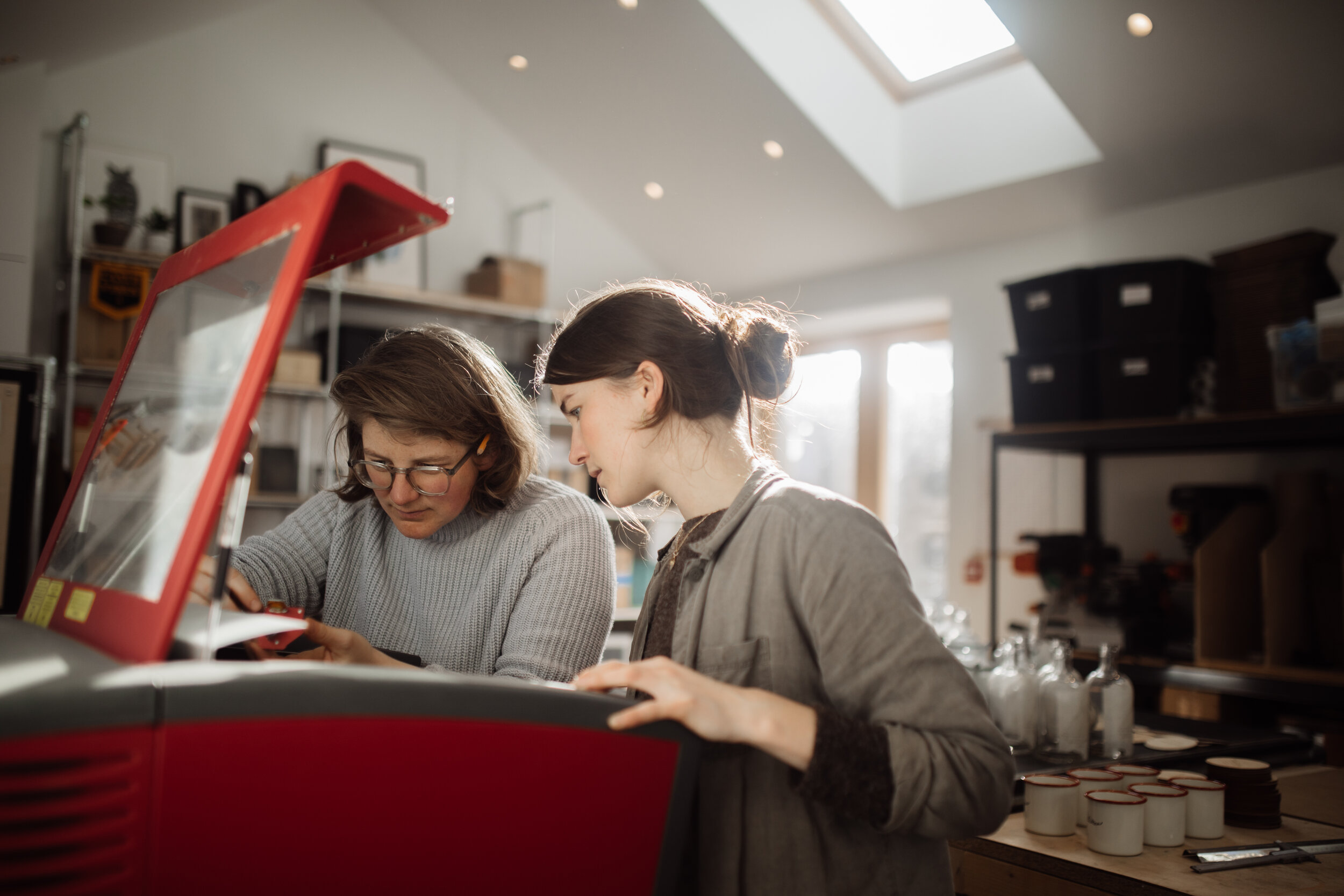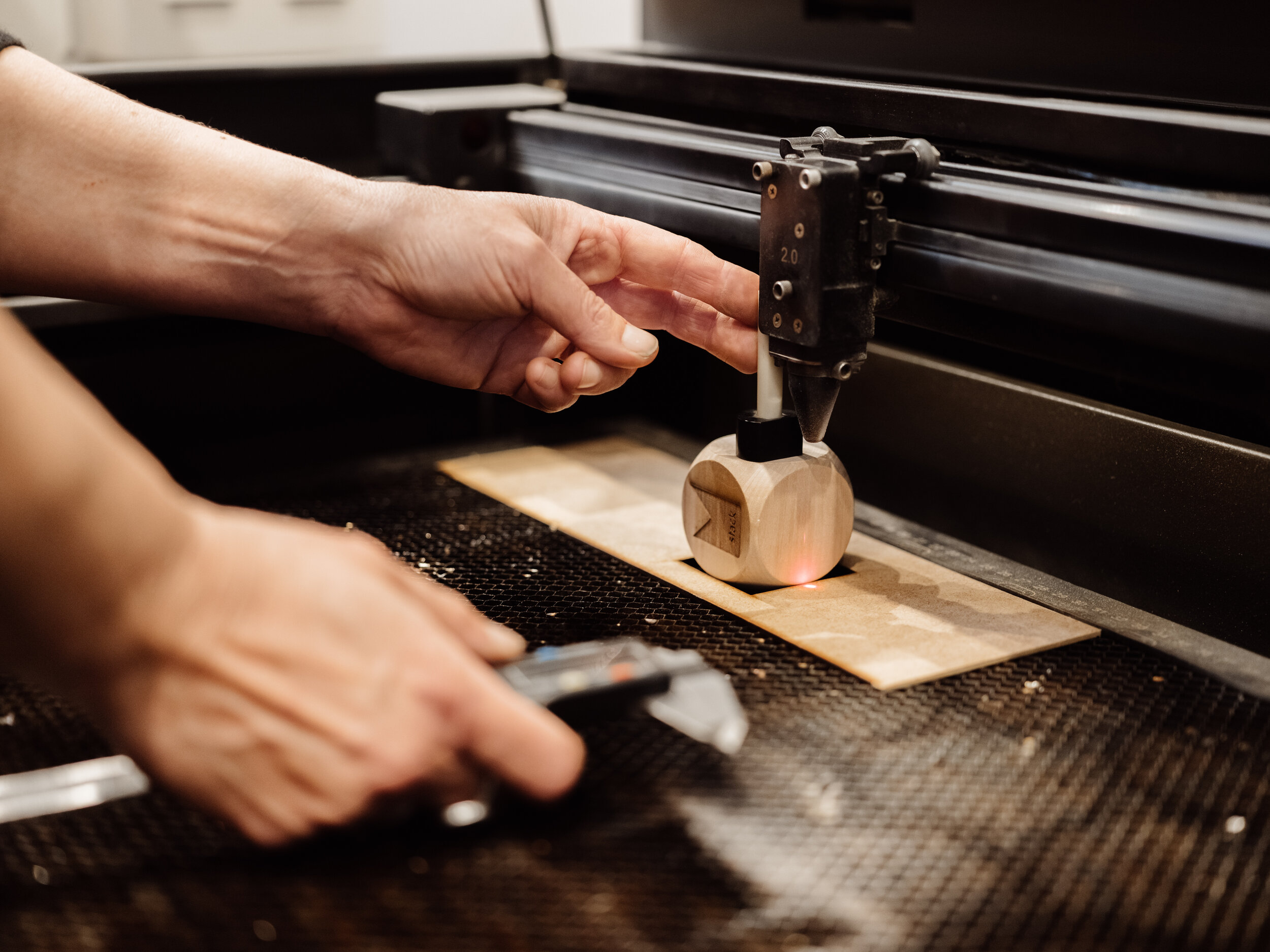One of our rewards for our crowdfunding campaign to send issue 10 to print are a pair of Trail Tea enamel mugs inspired by foraged teas you can make in the great outdoors. These mugs were engraved by Cut By Beam in their Cornish studio – join us as we find out more about the cutting process, their experience of lockdown, and the strangest object they’ve ever etched…
Images by Jenna Foxton
Tell us about Cut By Beam - who are you and what do you do?
Cut By Beam is a laser cutting business based near Falmouth, Cornwall. We’re an all-female team of four. I originally set things up about six years ago – my first workshop was a small, cold, farm building and I had one machine. Now we have four laser cutters and can handle a diverse range of jobs, for individuals as well as small to large businesses. We get to work with some incredibly talented clients - I discover more and more every week!
Take us through the cutting process – please do go into lots of geeky detail, we love that.
The laser cutters do all the cleverest bits but the prep-work beforehand can be quite creative. That might mean discussing ideas with clients, drawing up artwork for them and sourcing materials. We then program the machine with all the details it needs to know, for example the type - whether that’s wood, leather, rubber, stone, glass, enamel, etc, – the thickness and size of the material – from something just a few centimetres wide to over a few metres. The design is picked up from a folder on our server and then we tell the machine where to position the job on the laser bed and how many items to cut or etch. We can cut right through material or just etch or score the surface.
Were there any challenges to cutting the Trail Tea designs?
Enamel Mugs are one of our most popular items – we have an online store where people can order them individually, or we can take bulk orders like we did for Ernest. As we do these mugs all the time, we didn’t have any particular challenges on this job. The difference with etching curved surfaces, and in order to get an even finish, is that we have to rig up a rotary arm to turn as the laser does its work. Each mug has to be put on the machine individually so it can be quite labour intensive as there’s a change-over pretty regularly.
What's the most surprising thing you've ever etched?
Various things spring to mind. When we were based in our last farm building, we were asked to have our laser cutting included as part of a video to help promote the NASS music festival. A team came to make that in our workshop whilst we etched a skateboard for them. It was used to reveal the headlining act for that year.
We've also etched some bird skulls for a heavy metal band’s music video. That was definitely the strangest thing. One of the jobs we’re most proud of was when we made thousands of wooden cards for National Geographic. They wanted them to drop into the Ganges and help them trace the flow of plastic down the river.
Where do you turn for inspiration, particularly when you're having a creative lull?
Ideas can come from various sources but they’re usually from other creative businesses and individuals that we either work with or follow. It might be a podcast, a book or a talk we’ve listened to. A good example from last year was listening to Mark Jenkins, Director of the Cornish film Bait, who talked about how much more successful he felt his film had been because he had been on such a tight budget. Adversity can be the mother of invention and I was motivated by hearing that at a point where we were juggling decisions on whether to invest in a new machine or make existing ones work better.
What have you taken away from the lockdown experience?
We’ve been grateful to have enough work to keep us going throughout lockdown, though things were initially scaled back. We used the spare time to work ‘on’ our business rather than just ‘in’ it which, under normal circumstances, we find a challenge to make the time to do. We’re hoping to put in for B-Corp recognition soon, so we did some work towards that application. Although the uncertainty of the Covid-19 period has obviously been unsettling, we’ve enjoyed the chance to ‘breath’ a little and take stock of what is important to us as a business, which is staying true to our sustainable ethics and striving towards a healthy life/work balance.
Tell us about your work space - how does it reflect you as a team?
There are usually two or three of us on site at any one time. And then one or two working from home doing admin. The workshop is mainly just one large room and we’ve set it up so that we can easily work as a team in what could still be quite a tight space if we hadn’t planned it out well. Everyone is connected via apps on laptops and phones, so even when we’re not physically together we know where we’re up to on any particular job. I would say that our workspace is almost as much an online world as a physical one. We use an app called monday.com to schedule and follow all jobs. This has really helped make things more efficient and is of course accessible from anywhere. At heart, however, we love the physical and practical nature of our work so I would say the workshop definitely reflects us well, with examples of our work alongside our tools, materials and machines. We made quite a few of the workshop fittings ourselves.
Why do you love what you do?
When I left uni, my ambition was to continue to live in Cornwall, have a dog, a Land Rover, my own business, become a World Champion gig rower and have a great work/life balance. That last one is still a bit of a work in progress but I’ve ticked all the rest off. With a company still in its growth phase, there’s always more to be done, but I love my work and the people I meet through it, so I regard myself as incredibly lucky.




